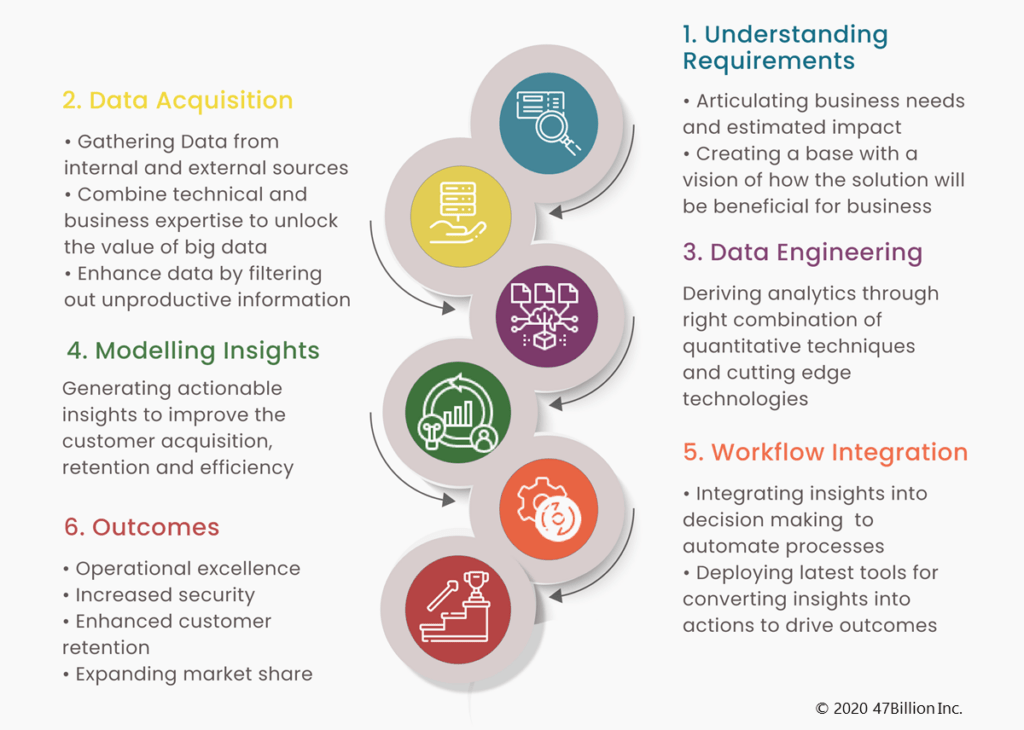Data has become as valuable as oil and is fueling digital transformation. An organization’s ability to make meaningful decisions in a volatile business environment is the key to competitive differentiation. Almost every industry vertical is investing explicitly in data analytics initiatives to adapt to dynamic market conditions, wired deeply into the customer mindset, and use data as a catalyst to accelerate business exponentially.
One Step at a Time – While everything above sounds so exciting, it is fairly a slippery and steep slope where a setting feat isn’t easy unless planned in a systematic fashion. As the classic divide and conquer approach never gets old, we always try to take one step at a time to embark on an effective transformation journey which can be broken down into following different stages:
1. Understanding Requirements
To achieve specific goals and generate actual value, data should address the specific business problems. These requirements become the major KPIs on which the foundation of data strategy can be laid with a validation approach to measure and manage.
The main goal of this stage is to translate the business needs into use cases that are creating a 360-degree view of the organization and working on process optimization.
2. Data Acquisition
With an understanding of business needs, we can turn to the next stage that is building sustainable data architecture and finding data sources for data collection. At this stage, organizations need to
- Collect and integrate the available data.
- Segregate and categorize it based on details available.
- Refill corrupt and missing data.
- Apply data integrity and validity check.
- Filter and store data in data warehouses.
- Extract the data
3. Data Engineering
It is the aspect of data science that focuses on making data more useful and accessible for consumers of the data. For this, organizations acquire analytical capabilities to derive insights from data, they either choose to add in-house capabilities or outsource to specialists. These analytics experts apply a broad spectrum of Analytics-based assets and market-tested approaches to derive meaningful insights from data. The various methods for data analytics are:
- Predictive Analytics
- Descriptive Analytics
- Prescriptive Analytics
- Pre-emptive Analytics
4. Data Visualization
Data Visualization is a key component of a data strategy. Various data visualization techniques make data interactive and easy to interpret. In this stage, organizations derive actionable insights by creating dashboards, scorecards, or customized reports. The significances of the visualization technique are:
- Quickly spot trends and avoid confusion with an effective presentation of data.
- The visualizations dashboards are capable of storytelling that is presenting the context of metrics and anticipating user path of diagnosis.
- Encourage widespread adoption.
- The visual presentation data with filters like time-period, demographics enable identification of relationships and patterns within.
5. Workflow Integration
This stage is all about integrating meaningful insights into the decisions and redesigning processes. Experts deploy new programs, tools, and processes, turning insights into actions and driving outcomes at scale. Companies reengineer their decision making in business units and functions to become analytics-driven. Department such as sales and marketing work more collaboratively and use analytics consistently.
6. Outcomes
The value-generating transformation strategy should fulfill objectives similar to the listed ones as follows:
Operational excellence – The value created by leveraging analytics to identify redundancies and inefficient processes result in reduced expenses.
Reduced risk and fraud – Real-time issues monitoring, predictive modeling can help in mitigating risks. Also, fraud can be prevented by safeguarding the ecosystem with compliance.
Enhanced customer retention and greater revenue generation – The value derived from a better understanding of potential customer segments enables greater revenue generation, improved customer satisfaction, and long-term customer loyalty.







